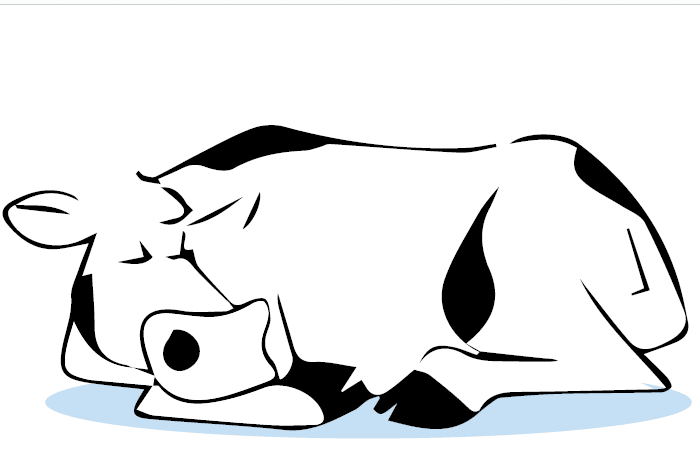By Dawn Dalley
Farmers often tell me that caring for their cows and the environment lies at the heart of their dairy farming practice. Over winter, ensuring we are doing daily checks and reacting to our animals’ behaviour and to weather conditions is essential.
Implementing good management practices will help you make a difference this winter. Below are some of the main areas you should be considering, to support your animals’ health and comfort.
LYING TIME
Cows need to lie for at least 8 hours per day to maintain their health and comfort. We have observed that these needs are often met, but some animals do not achieve this throughout winter.
Research has shown that during and on the day after rainfall events, some animals do not sit down for up to 24 hours due to sodden soil conditions with water pooling. Once the weather improved, they spent more time lying down, to compensate.
IDENTIFYING SUITABLE LYING AREAS
We need to provide cows with a comfortable lying surface, but what does that look like?
Cows prefer soil which is ‘crumbly’. If you were to pick up a handful of soil you could clump it together, but your hands would still be relatively clean from mud.
To truly assess this onfarm, try using the gumboot scoring method. If you put your gumboot into the ground, observe the pooling of water in the print. If it quickly fills up with water or the soil oozes into the footprint, then the ground is too wet for a cow to find comfortable.
You want to see a boot imprint with no liquid pooling.
Wet mud and surface pooling of water will have a negative impact on lying time, so a suitable lying area should be provided, especially if weather conditions do not improve within 24 hours.
PROVIDING A COMFORTABLE LYING SURFACE
Here are a few suggestions of how you can do this:
- Move the break fence regularly to provide fresh ground, as long as it does not result in overallocation of crop and create potential nutritional risks.
- Strategically graze the paddock, avoiding wet areas.
- Protect the area closest to the feeding face by grazing animals into the prevailing weather conditions.
- Save drier areas, especially any with shelter, for your contingency plan.
During wet conditions allow cows more space by giving access to ground behind the back fence if that ground is suitable for lying.
- Keep supplement feed and water troughs near the feeding face, not in any swales or hollows, which may create excess mud.
- Roll out hay or straw for cows to lie down on.
- If you have limited options, put cows that will be most affected by a period of poor weather (younger, lighter, earlier calvers) into paddocks with the most shelter, best soil condition or best feed.
IMPLEMENTING CONTINGENCY PLANS
It’s important you and your team know when to implement your contingency plan.
Assessing the main three factors – paddock, animals and weather will help you make an informed decision.
- During daily checks, consider the factors below for deciding when to implement your contingency plan.
Paddock:
- What does the current break look like?
- What is the gumboot score?
- What is the next break like? Would the cows be moving into a drier area?
- Has the next break got any shelter?
Animals:
- Are you able to see where the animals have been lying? Finding ‘lying bowls’, the marks cows leave in the soft crumbly soil, indicates that animals have been lying there.
- Do your cows have a lot of wet mud on their flank? This indicates they have been lying on a sodden surface, and alternatives need to be provided.
- How are your animals acting? Calm and content, or getting restless? Is this normal behaviour for your herd?
Weather:
- What are the conditions? Are you only experiencing rain, or a combination of rain, wind and low temperatures? This combination means extra feed may also be required.
- Is the weather likely to improve or worsen?
- Dawn Dalley is a DairyNZ senior scientist.
STRATEGIC GRAZING
There are a few different options to consider.
- Graze towards critical source areas (CSA) or water bodies to protect them from overland flow.
- Ensure grass buffers around CSA’s are left ungrazed until the end of winter.
- If you have cultivated your CSA, create a buffer of ungrazed crop to protect the CSA and eat this off at the end of winter. Next winter remember to identify and leave CSA’s uncultivated.
- Graze from the top of the slope down to reduce overland flow, by maintaining soil structure and allowing water to soak into undamaged soil.
- If you don’t want to graze your animals downhill, graze across a slope with a buffer at the bottom.
- Save breaks near shelter or drier areas for your contingency plan.
No two farms will have the same threshold for implementing a plan B. Plan with your team in advance, so everyone is on the same page for implementing your contingency plan and understand daily expectations during winter.
- Winter grazing plans and additional information to support farmers this winter are available at dairynz.co.nz/wintering.





